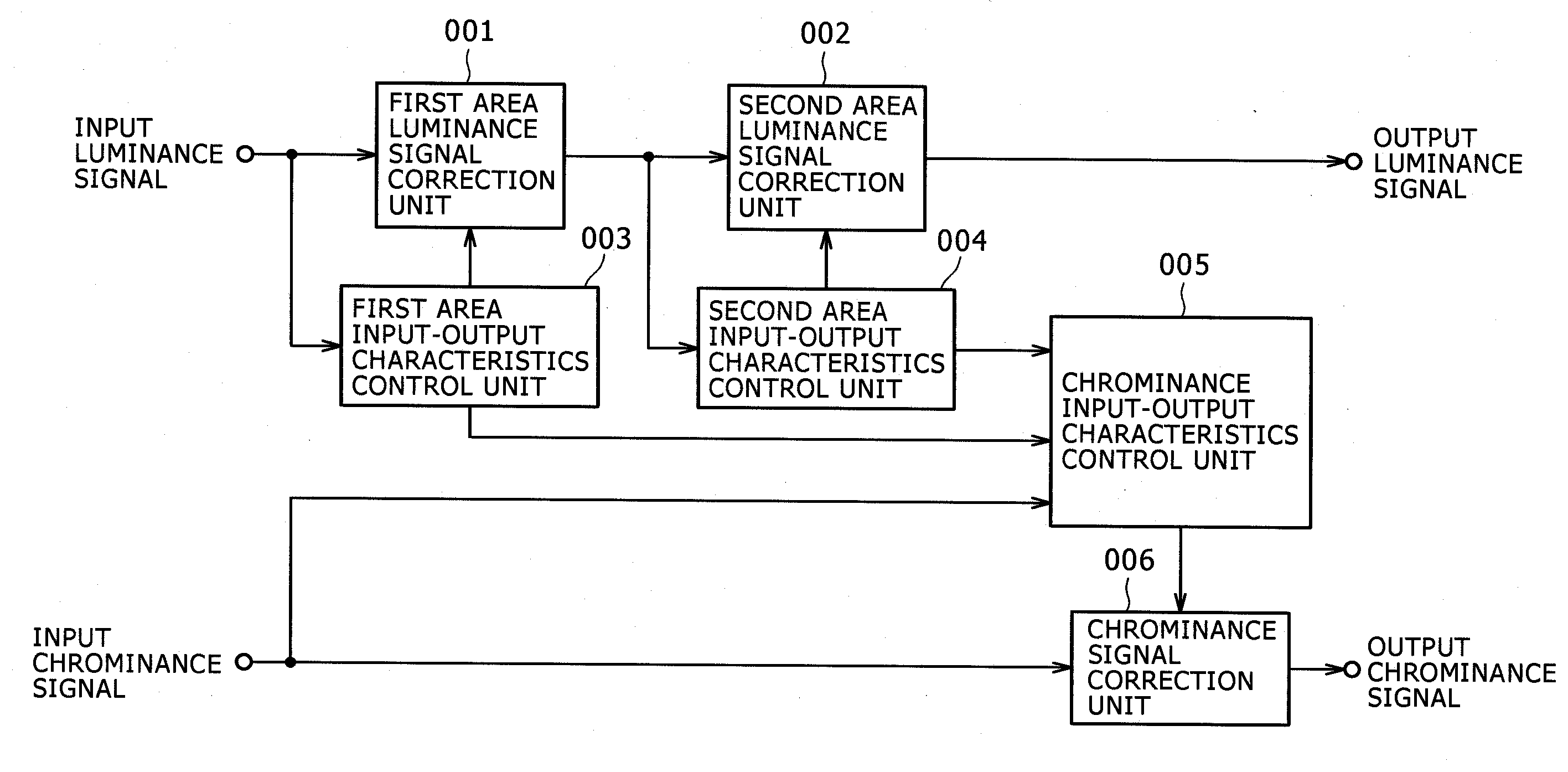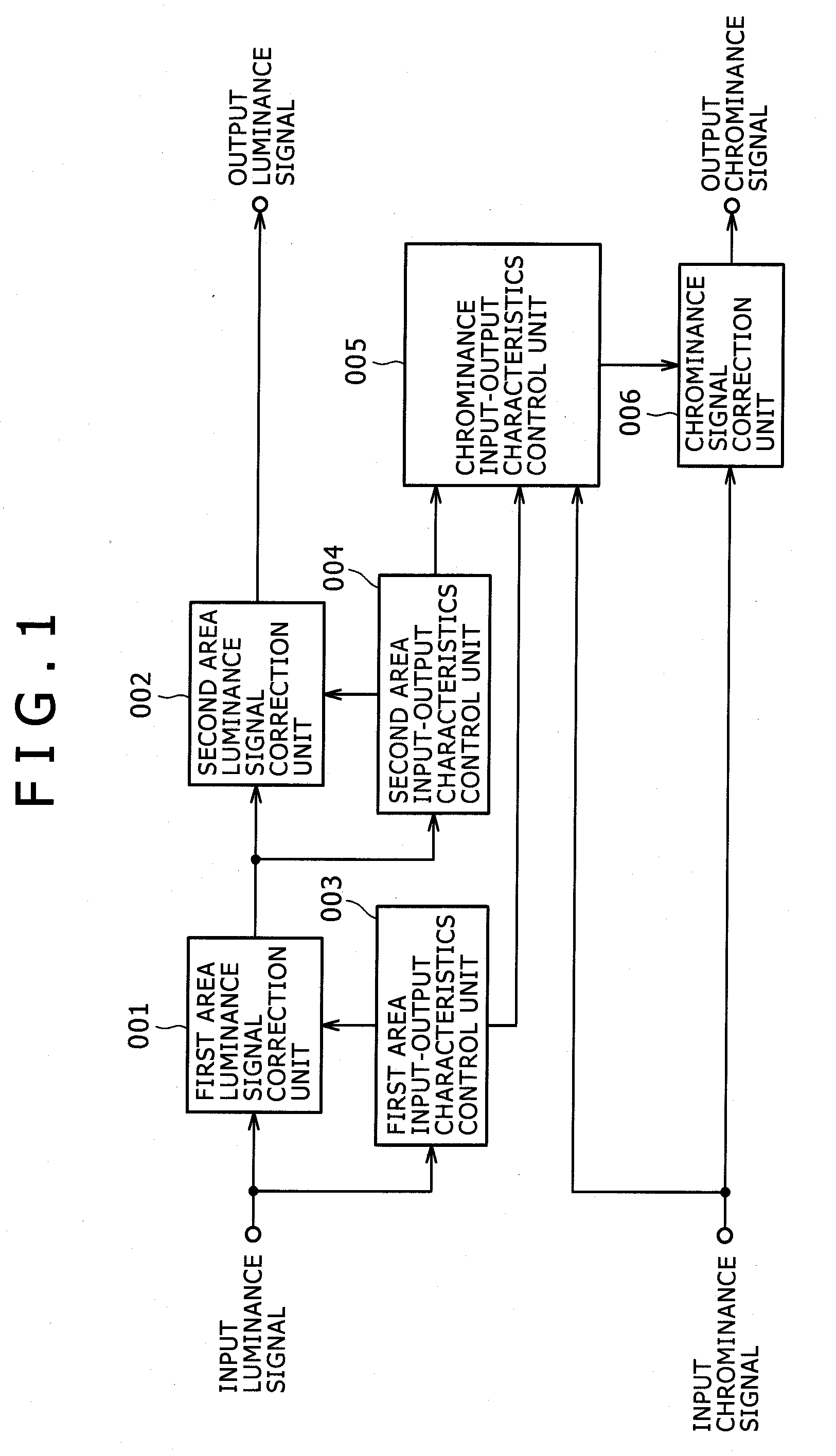Image signal processing device
- Summary
- Abstract
- Description
- Claims
- Application Information
AI Technical Summary
Benefits of technology
Problems solved by technology
Method used
Image
Examples
embodiment 1
[0036]FIG. 1 illustrates a concept of Embodiment 1 according to the present invention.
[0037]A first area input-output characteristics control unit 003 performs control for changing input-output characteristics in an arbitrary small area of an image, using information on a local area which includes peripheral pixels of the arbitrary small area.
[0038]A first area luminance signal correction unit 001 corrects the input-output characteristics of an input luminance signal for every small area according to an output of the first area input-output characteristics control unit 003.
[0039]FIG. 3 illustrates an example of a concept of the first area unit. The left-hand side of FIG. 3 illustrates an input image which possesses a dark area like blocked-up shadows, a bright area like blown-out highlights, and an ordinary area with originally clear gradation. The right-hand side of FIG. 3 illustrates input-output characteristics for improving contrast of each area.
[0040]On the basis of the informa...
embodiment 2
[0048]FIG. 2 illustrates a conceptual diagram of Embodiment 2 according to the present invention.
[0049]An index value calculation unit 101 outputs an index value which is calculated by performing predetermined weighting to a central pixel and its peripheral pixels of an input luminance signal. It is also preferable to assume that the predetermined weighting is to calculate a mean value.
[0050]A luminance-corrective blending ratio calculation unit 102 calculates and outputs a blending ratio with which an output of a memory unit 103 and the input luminance signal are blended.
[0051]FIG. 4 illustrates an example of a blending ratio calculation method for luminance correction. In FIG. 4, a symbol x expresses an index value used as an output of the index value calculation unit 101 (FIG. 2). A symbol x1 expresses a threshold indicative of a low luminance area. A symbol x2 expresses a threshold indicative of a high luminance area. A symbol y1 expresses an intercept of the low luminance area....
embodiment 3
[0070]FIG. 10 illustrates an image signal processing device according to Embodiment 3 of the present invention.
[0071]In FIG. 10, a block 1014 is a first contrast correcting circuit and a block 1015 is a second contrast correcting circuit. A signal flow in FIG. 10 is explained in the following. A representative luminance level of a prescribed area in an input luminance signal is first calculated by a representative luminance calculation circuit 1001, and the input luminance signal is corrected to predetermined characteristics by a luminance signal correction circuit 1002. The input-output characteristics of the luminance signal correction circuit 1002 are described later.
[0072]According to an output of the representative luminance calculation circuit 1001, a rate-of-blending generation circuit 1003 generates a predetermined rate of blending a (0=a=1). An output of the luminance signal correction circuit 1002 is multiplied by (1−a) by a multiplier circuit 1005, and an input luminance ...
PUM
 Login to View More
Login to View More Abstract
Description
Claims
Application Information
 Login to View More
Login to View More - R&D
- Intellectual Property
- Life Sciences
- Materials
- Tech Scout
- Unparalleled Data Quality
- Higher Quality Content
- 60% Fewer Hallucinations
Browse by: Latest US Patents, China's latest patents, Technical Efficacy Thesaurus, Application Domain, Technology Topic, Popular Technical Reports.
© 2025 PatSnap. All rights reserved.Legal|Privacy policy|Modern Slavery Act Transparency Statement|Sitemap|About US| Contact US: help@patsnap.com



